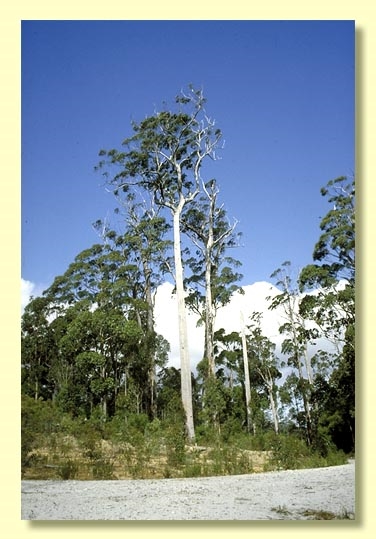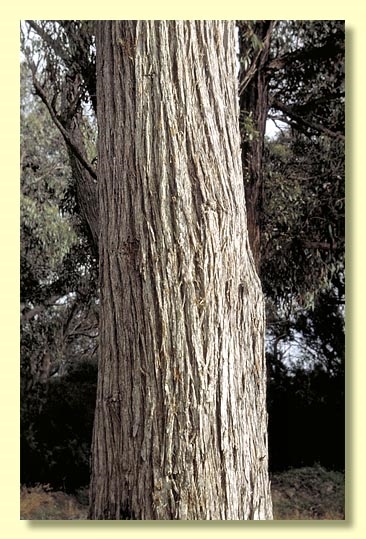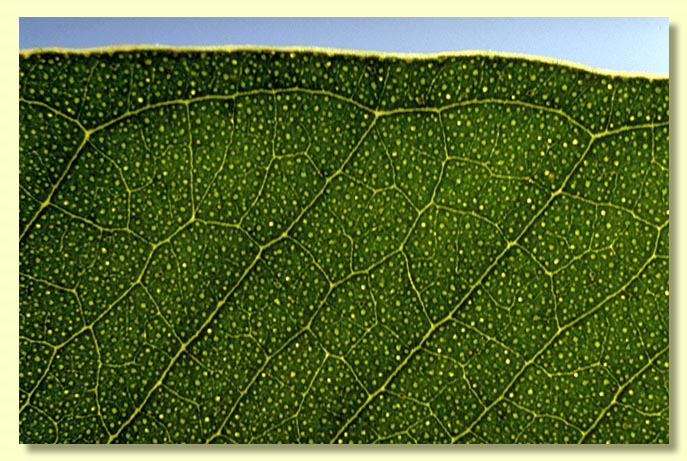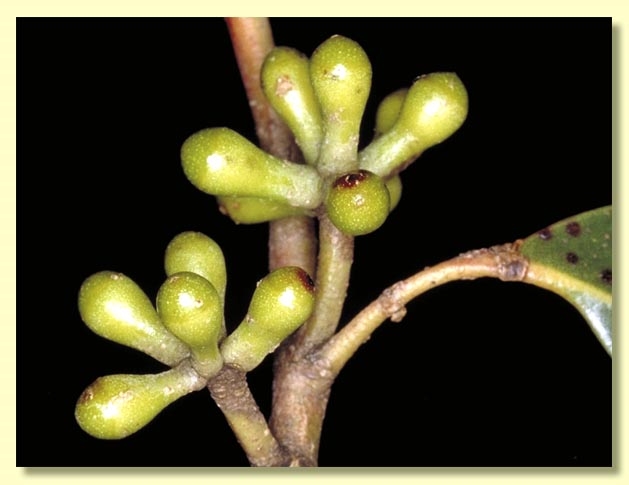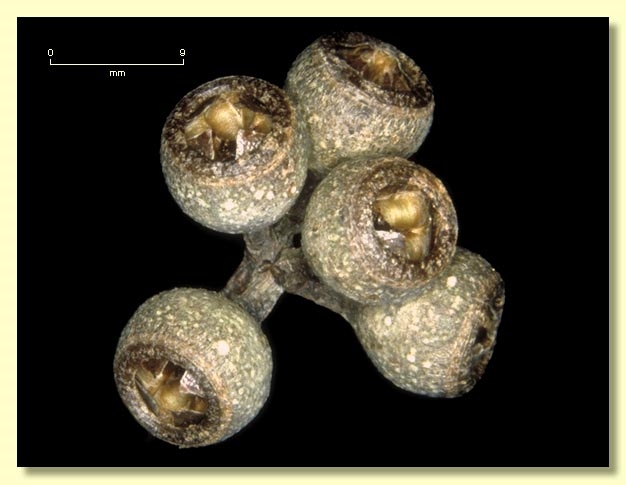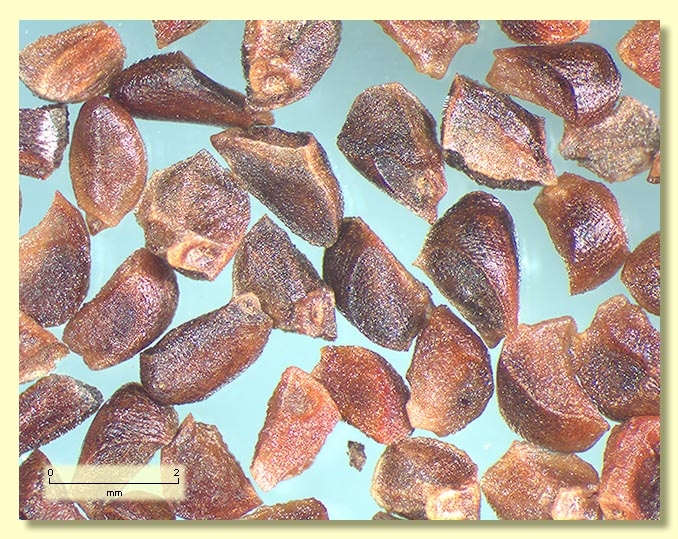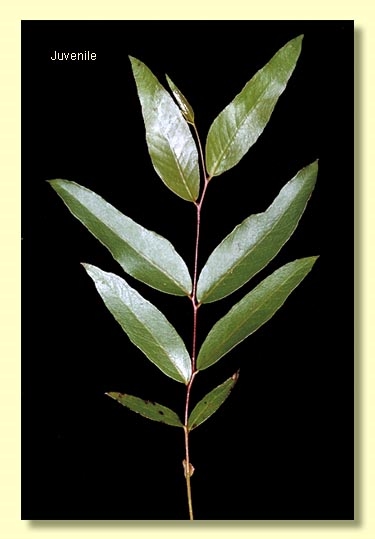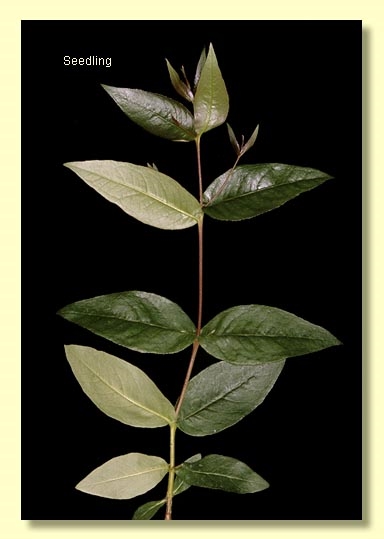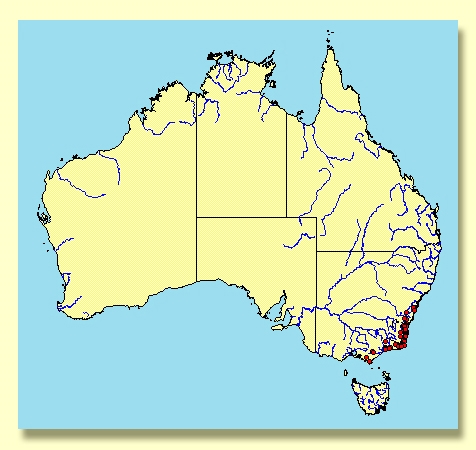Euclid - Online edition
Eucalyptus muelleriana
Eucalyptus | Eucalyptus | Capillulus | Pachyphloius
T: Nine Mile Ck [near Hedley], South Gippsland, Vic., A.W.Howitt 6; lecto: MEL, fide J.H.Willis, Muelleria 1: 167 (1967).
Eucalyptus dextropinea R.T.Baker, Proc. Linn. Soc. New South Wales 23: 417, t. xi (1898). T: Monga, NSW, W.Bäuerlen s.n.; syn: NSW; Barbers Ck, NSW, July 1898, H.J.Rumsey; isosyn: K.
Bark rough to small branches, stringy, grey-brown to grey-yellow.
Juvenile growth (coppice or field seedlings to 50 cm): stem rounded in cross-section, sparsely scabrid; juvenile leaves opposite and sessile for about 10 or so pairs, then alternate, petiolate, broad to narrow lanceolate, 5.5–13.5 cm long, 1–5 cm wide, base rounded to tapering, discolorous, glossy, dark green; stem, petiole, leaf margin and midrib underneath sparsely scabrid for lower 1–10 leaf pairs only.
Adult leaves alternate, petiole 0.5–2 cm long; blade lanceolate to falcate, 8–20 cm long, 1.5–4.5 cm wide, base usually oblique, discolorous or weakly so, glossy, green, side-veins at an acute or wider angle to midrib, sparsely reticulate, intramarginal vein parallel to and well removed from margin, oil glands round, island.
Inflorescence axillary unbranched, peduncles 0.5–2 cm long, buds in umbels of 7, 9 or 11, pedicels 0.2–0.5 cm long. Mature buds obovoid, 0.5–0.7 cm long, 0.3–0.4 cm wide, glossy, green, scar absent, operculum conical to rounded, stamens irregularly flexed, anthers reniform to cordate, versatile, dorsifixed, dehiscing by confluent slits (usually), style long, stigma tapered or blunt, locules 3 or 4, the placentae each with 2 vertical ovule rows. Flowers white.
Fruit on pedicels 0.1–0.5 cm long, cup-shaped to truncate-globose, 0.6–1 cm long, 0.7–1.2 cm wide, disc raised-convex to annular or level to slightly descending, valves 3 or 4, scarcely exserted or near rim level.
Seeds black or brown, 1.5–3 mm long, pyramidal or obliquely pyramidal, dorsal surface smooth, hilum terminal.
Cultivated seedlings (measured at ca node 10): cotyledons reniform; stems rounded in cross-section, scabrid; leaves sessile to very shortly petiolate, opposite for ca 12 pairs, then alternate, lanceolate, 5–14 cm long, 2.2–4.5 cm wide, amplexicaul or the base rounded to tapering or oblique, margin irregular to entire, apex pointed, discolorous, glossy, darker green above. Leaves glabrous on upper surface whilst lower surface is only scabrid on midrib and margin.
Flowering has been recorded in January, February, March and May.
In Western Australia Eucalyptus muelleriana has escaped from plantings and become naturalised (Hussey et al., 1997).
A medium-sized to tall stringybark tree of coastal plains and foothills of south-eastern Australia from Wollongong New South Wales to Wilsons Promontory in Victoria. Eucalyptus muelleriana is fully rough-barked with a glossy green crown of weakly discolorous leaves, pedicellate club-shaped buds and cupular to truncate-globose fruit with the disc usually level to descending and valves at more or less rim level. Juvenile growth is only slightly scabrid with the leaves very glossy and discolorous.
Within its natural range E. muelleriana is distinguished from other stringybarks by fruit features, especially pedicels, shape and size. The fruit are not flattened (i.e. not wider than long) nor crowded together as in E. globoidea, E. agglomerata and E. capitellata. E. blaxlandii differs from E. muelleriana in having smooth-barked branches and more hemispherical fruit. The widespread E. baxteri differs from E. muelleriana in the buds which are often sessile with an obtuse to rounded operculum that is weakly to obviously warty, and coarser juvenile leaves. E. eugenioides differs in the smaller pointy buds, thinner-textured crown leaves and juvenile leaves that are scabrid/hairy for many nodes.
MORE ABOUT STRINGYBARKS

